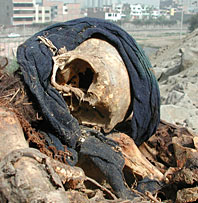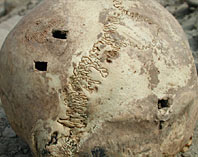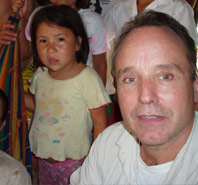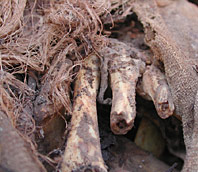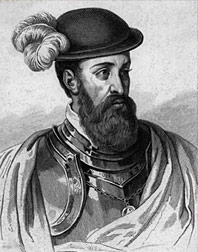The Producer's Story:
Unearthing Suppressed History
by Graham Townsley
When I first looked at background material on the project
that became "The Great Inca Rebellion," I had mixed feelings, I
must admit. I loved the idea of returning to Peru. I had spent many years there
as an anthropology graduate student doing the fieldwork for my doctorate at
Cambridge, and the place is very close to my heart. It has always inspired me.
But when I looked hard at the story, my secret thoughts were these: Here we go
again, another one of those TV films that make a big deal out of a minor
archeological find, and we get to tell the story of the conquest of Peru for
the 200th time!
The story seemed slight. I thought I knew exactly how it
would all evolve.
It wasn't. I didn't.
That perfectly round little hole in that 500-year-old
skull—if you haven't seen the film, have a quick look at the
program description to learn what I'm talking about—that hole
turned out to be the doorway to one of the most exciting scientific and
intellectual adventures I have ever been part of.
Shaking an edifice
The scientific questions were clear enough: Was this or
was this not a bullet hole? Were these or were these not the victims of the
first battles of the conquest of Peru? If we could get a conclusive forensic
result, that in itself would have been a real first: the first-ever forensic
remains from one of the battles of the conquest, not just in Peru but anywhere
in the Americas. In my experience, absolutely conclusive archeological or
forensic results are few and far between, so I was amazed when we actually did
get a conclusive result. It really was a bullet wound. These really were the first victims of the
conquest ever found. And it was all beyond a shadow of any reasonable doubt.
The forensic trail was fascinating enough, but it was
just the beginning of the adventure. When we were able to put the forensics
together with a statistical analysis of the remains showing that although these
individuals clearly died in a conquest skirmish, most of them appeared to have
been killed not by Spanish weapons but by Indian ones—at that point things became even
more interesting. When we connected those results up with painstaking and
pioneering work done over the past few decades by historians of the conquest, I
realized we had the makings of something truly remarkable—a new vision of
the conquest and a radical deconstruction of one of the grand narratives of
world history, the European conquest of the Americas.
Pizarro's conquest of Peru is at the core of that
long-established narrative and has traditionally been taken to exemplify its
key themes: the great march of European expansion, the West's invincible
technological prowess, the cosmic bad luck of the Indians' lack of
resistance to European diseases, the tragic but beautiful Indian inability to
comprehend what was happening to them, and so on. But here was a discovery that
seemed to challenge all of that.
Reconstructing the story
The forensic side of the story started with the Peruvian
archeologist Guillermo Cock's discovery of a mass grave of Indians, whom
he was able to determine were killed at one of the most famous battles of the
conquest, the Siege of Lima. This battle has conventionally been portrayed as
the brave rout of a vast Inca army by a handful of wily and determined
conquistadors commanded by Pizarro. Cock's discoveries pointed in the
opposite direction. This pivotal battle of the conquest was won not by Spanish
cruelty or brilliance, not by European technological superiority, nor by
European diseases. This was essentially a clash of Indians against Indians.
I felt like I was creating a collective memory
for people and events erased from history.
And this, I found, corroborated the recent findings of
historians like the Peruvian Maria Rostworowski, who, in long-forgotten legal
documents, have found striking evidence of the broad scope of the alliances
between conquistadors and rebel Peruvian chiefdoms that were anxious to free
themselves from Inca domination.
Again, I saw the potential for a really captivating film:
not only a genuinely new story to tell about the conquest, but a very poignant
human drama, the final day and deaths of the people killed at the Siege of
Lima.
What was that day like? What did Mochito—the Indian
whose brutalized remains led researchers to give him this name, meaning
"the severed one"—and his people think as they went off to
their deaths? To spend days around their battered skeletons, hear from the
forensic scientists about the moment of each person's death, learn from
the archeologists and historians what was probably going on around them as they
died, became a strangely moving experience. The longer I spent trying to
imagine their last day, the closer I felt to them.
It became very important to me to tell the stories of
their lives and deaths well. I felt like I was creating a collective memory for
people and events erased from history because they didn't fit a narrative
constructed by their conquerors. I went to great pains to try and recreate that
last day of their lives as faithfully as possible. The actors and extras were
wonderful. Mostly drama students or actors working in Peruvian soap operas,
they threw themselves into the project with great enthusiasm. Like everybody
involved with the film, I think they found it refreshing to help tell a quite
different story of the conquest from the account they had all grown up with.
No simple heroes
The production left us all with vivid memories and big
questions. What does it do to the traditional narrative of the conquest to
learn that its battles were overwhelmingly decided not by Spanish technological
or intellectual superiority but by bitter conflicts within the Indian world?
That the Spanish were to some extent bystanders of an Indian civil war?
The first thing it does is to complicate our
understanding in compelling ways. The conquest of Peru looks less like the
inevitable march of European expansion and more like a fluke. Pizarro looks
less like a conquering hero and more like the adventurer he was, who had the
enormous good fortune to wander into an Indian civil war and the wit to know
how to manipulate it to his advantage. The Inca look less like noble victims
and more like complex human beings with sophisticated thinking and complex
motivations, some of them just as low and scheming as the Europeans'.
Suddenly everything appears a lot messier and more interesting. We no longer
have a saga with clear heroes, villains, and victims. We're back in the
real world, where things never quite happen the way they do in stories.
In a funny way, making this film also restored
my faith in television documentary.
The realities we reveal in our film also raise the
intriguing question of why all this was erased from history in the first place.
We did not have space to delve into this in detail, but it is fascinating and
really deserves its own film. On the one hand, it is easy to see how the true
story of the conquest does not flatter anybody involved, for exactly the
reasons outlined above. Nobody comes out as either good hero or good victim,
and much in terms of self-image was at stake in maintaining those roles.
History's higher stakes
There were also, however, very real political and
economic considerations. The conquistadors enlisted the massive support of
Indian allies by promising them huge payoffs once the war was over. They would
receive lands, money, and influence. When the war really was "won,"
it was enormously beneficial economically to the conquistadors to simply forget
their promises and debts. And who, after all, was going to enforce them?
On the Indian side of the equation the dilemmas were
harsher. When the great chiefs who had allied themselves with the Spanish
realized that they were not, as they had thought, equal partners in the
much-desired ousting of the Incas but had in fact colluded in the
self-destruction of their entire world, they were horrified and, finally,
ashamed. Naturally, they did not want to go down in the grand narrative as the
collaborators who had betrayed their own people. So they too had something to
gain from a tale of inexorable Spanish victory. It at least allowed them to
salvage some pride from the disaster.
Faith restored
I find all this curiously moving and powerful. It seems
to restore to the world of Inca Peru, so complex and divided against itself, a
sort of epic and tragic grandeur.
In a funny way, making this film also restored my faith
in television documentary. As I said earlier, like all filmmakers I know all
too well the pressure to always simplify, to rehash old, well-known stories in
an attempt to make them entertaining all over again. It sometimes seems that TV
lives in a world of endlessly recycled cliché.
"The Great Inca Rebellion" was different.
NOVA immediately bought into the freshness and rich complexity of the story,
and the whole experience was heartening. It reminded me that it is possible to
tell new and intricate stories on TV, and that people want to see them. That
potential is, after all, why I became a filmmaker in the first place.

